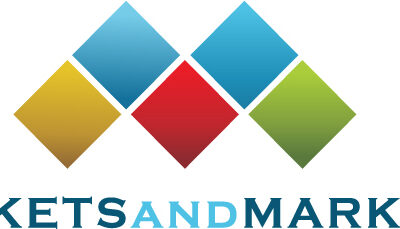Tech
Learn To Ride The AI And Blockchain Tech Tsunami

New Education Methods (Photo by Qu honglun/China News Service via Getty Images)
China News Service via Getty Images
In the emerging tech space, having strong education really makes a difference in your ability to win the highest-possible salary and, even more importantly, to enhance your decision making and increase innovation for your new company. With LinkedIn Data predicting a 65% shift in job skills by 2030 due to AI and Blockchain, we need to learn both in traditional ways and in new ways.
The trend of requiring degrees for jobs irrespective of their relevance, known as “degree inflation,” began in the early 2000s, sidelining skilled workers without formal education.This shift away from traditional education prerequisites signifies a broader transformation in job qualification narratives, advocating for skills over degrees.
Initiatives to prioritize skills and competencies over academic credentials have gained momentum. A pivotal move was made towards skills-based hiring within federal employment practices. Mirroring this progressive stance, over 16 states have enacted legislation aimed at dismantling degree requirements for public sector jobs. This evolving landscape heralds the dismantling of the ‘paper ceiling,’ championing a skills-first approach that promises to redefine the workforce, making it more inclusive and meritocratic.
A woman views historical documents and photographs displayed in a high tech art installation at … [+] Salt Galata in Istanbul, Turkey. (Photo by Chris McGrath/Getty Images)
Getty Images
Emerging technologies are rapidly driving the creation of new education models that emphasize real-world simulations to maximize learners’ outcomes. This means not only new topics to learn but also new ways to study. Ambitious professionals at all career stages must understand new developments in AI and blockchain. So, what does a great education look like?
Value of Education
Multiple reports on emerging jobs have consistently highlighted roles in AI and blockchain among the fastest-growing job categories; meanwhile analysts predict that the AI market will grow by a factor of 20 over the course of the ‘20s. According to these same surveys, roles requiring knowledge of AI and blockchain are among the highest paying in the tech sector. For example, blockchain developers and AI specialists often pay higher than their counterparts in other IT roles.
And make no mistake: upskilling doesn’t just benefit the individual. Companies that invest in employee AI and blockchain education see major improvements in innovation and productivity. According to a Deloitte survey, organizations that use these technologies effectively are more likely to report strong growth. Employees skilled in AI and blockchain can drive innovation by developing new products, services, and processes.
Fortune/Deloitte CEO Survey
Fortune/Deloitte CEO Survey
A PwC report suggests that AI could contribute up to $15.7 trillion to the global economy by 2030. Companies with employees skilled in these areas are better positioned to tap into this potential, and gain a competitive edge in their industries.
We must never forget that technology is a tool, and it’s useless (or worse!) if we don’t have the knowledge or skills to use it effectively. Ben Bartlett, Vice Mayor of Berkeley, puts it best: “Here’s the thing – education and innovation are essential to advance the human cause. The conditions of the world are becoming so hard on people. In order to avoid reaching a breaking point, we need to advance an equitable expansion of resources. It’s important for education systems to embrace innovation and advance the human cause.”
Ben Bartlett, Vice Mayor of Berkeley
Ben Bartlett, Vice Mayor of Berkeley
Here are some of the new forms of education in the Age of AI.
Hackathons:
These intense, often highly focused events are a hotbed for creativity, where participants ranging from students to seasoned professionals dive into the depths of problem-solving and rapid prototyping. In the collaborative spirit of hackathons, individuals learn by doing, a principle that stands at the heart of educational philosophies that champion active learning. They are pushed to explore new technologies, tools, and methodologies, bridging the gap between knowing and understanding.
Hackathons exemplify the power of collaborative learning and the synthesis of diverse skill sets. This crucible of collective intelligence is invaluable for learning as it mirrors the dynamics of the modern workplace, where interdisciplinary collaboration is key to innovation. The hands-on experience gained in hackathons goes beyond technical skills; it encompasses teamwork, communication, and time management — all essential attributes for personal and professional growth. Through the iterative cycle of ideation, creation, and presentation, hackathons provide a microcosm of the project lifecycle, offering a practical education that empowers individuals to transform ideas into tangible outcomes.
ETHDenver BuidlWeek
ETHDenver
For example, the blockchain conference ETHDenver sponsors a hackathon every year to help companies learn about the power of AI and blockchain. ETHDenver is the world’s largest Web3 and Ethereum-based innovation festival.
“ETHDenver has been hosting #BUIDLWeek and the #BUIDLathon as a way to bring together people from diverse backgrounds and skill levels who share a common interest in blockchain. It is a major part of the world’s largest innovation festival. These events are crucial for developing skills, and educating festival attendees (BUIDLers) through a range of technical presentations, workshops, and mini-summits,” John Paller, the Co-Founder and Executive Steward of ETHDenver, explained to me.
He continued with some very important points on community. “Community engagement is another important factor for #BUIDLWeek and the #BUIDLathon as it allows people to connect in real life, network, and develop a deep sense of community. Our mentors and speakers are world-class, coming from the top protocols and platforms from all over the world to be here. The same goes for our judges. We are a big tent and a blank canvas to empower people to come together and build the next big project or upgrade. #BUIDLWeek and the #BUIDLathon help to promote adoption and acceptance of blockchain technology. It’s an opportunity for the curious to learn and see first-hand what is possible within this wild world of Web3. These events serve as a catalyst for innovation.”
The New Targeted University:
Many focused, university-like programs are popping up to deal with the challenge of people struggling to understand emerging technologies. For example, De University of Ethereum
ETH
(UETH) has been created to meet the urgent need to train the next generation on blockchain. To date, this program has brought on over 100 chapters from around the world who are interested in getting access to resources to help their local blockchain clubs and university communities grow. This program provides a clear path to help students make their way from initial education to project-based learning with mentorship support, which leads to acceleration and funding for top projects.
Rachel Brissenden, UETH
Rachel Brissenden, UETH
“When it comes to blockchain adoption, education is essential,” says Rachel Brissenden, who curates, leads and hosts workshops at UETH “We need to put an emphasis on showcasing how blockchain solves real problems, while offering individuals a clear pathway to get involved. After hosting weekly UETH workshops and facilitating in person workshops at colleges like USC and UCLA, the following is clear to me: the next generation is HUNGRY to learn how blockchain can be leveraged for good. Students around the world are getting excited about it, and I am enthusiastic about our efforts at UETH to foster that spark!”
Bootcamps:
By providing hands-on, practical training, these boot camps prepare participants for immediate, impactful engagement with emerging technologies.
An exemplary manifestation of this approach is the 100 Girls in Blockch(AI)n initiative, aimed at harnessing the potential of blockchain and artificial intelligence to address the challenges faced by India’s ‘bottom billion’. This venture not only equips 100 girls with cutting-edge skills but also positions them at the forefront of creating generative AI solutions across critical sectors such as education, agriculture, healthcare, and finance.
Priyanka Kamath, CEO and Founder, 100 Girls In Blockch(AI)in with participants in the bootcamp
Priyanka Kamath
As Priyanka Kamath, founder 100 Girls GenAi, explained to me: “The 100 GIGA project is developing large language models (LLMs) tailored for India’s diverse and underserved populations in smaller cities, focusing on education, finance, healthcare, and agriculture sectors. It aims to support millions of students and farmers, reduce school dropouts, and decrease the workload of pediatric surgeons, leveraging AI for societal improvements. These scalable AI solutions are set to be launched on AWS Marketplace, built upon advanced foundational models like Llama2 and Claude Cohere for widespread access.”
Girls In Tech Bootcamp
Girls in Tech
Another group that understands the immense significance of innovation and emerging technology is Girls in Tech, the organization dedicated to empowering women (I am a board member). Across the globe, girls and women are encouraged to become leaders. Not only does it pave the way for gender equality in traditionally male-dominated fields, but it also ensures diverse perspectives and solutions in technological advancements.
Adriana Gascoigne, Founder and CEO of Girls in Tech, emphasizes the critical role of innovation and education in shaping the future of technology. She states, “Innovation is the lifeblood of progress, and education is its catalyst. At Girls in Tech, we recognize the transformative power of emerging technologies like AI. Our commitment to fostering innovation and providing educational opportunities is evident in initiatives like the Girls in Tech’s Emerging Tech in AI Bootcamp.”
Adriana Gascoigne, CEO and Founder
Girls in Tech Bootcamp
AI to learn about AI:
As the demand for task automation and personalized learning experiences grows, technologies within AI such as Natural Language Processing, Machine Learning, Speech, and Image Recognition are significantly enhance the educational landscape, providing customized lessons, round-the-clock support, and automated assessments that could revolutionize how students learn. Reflecting this trend, a P&S Intelligence market report notes that the value of the global AI in education sector, which was at $1.1 billion in 2019, is anticipated to surge to $25.7 billion by 2030, with a compound annual growth rate (CAGR) of 32.9% from 2020 to 2030.
The AI Education Project is a non-profit organization that creates equitable learning experiences to empower students with AI literacy. They provide a range of learning materials and resources that aim to make AI education accessible to all students, including those from vulnerable communities. DataCamp offers guidance on how to learn AI from scratch, covering the prerequisite skills such as basic mathematics and programming, before diving deeper into specialist AI skills like statistics, mathematics, programming, and data manipulation.
PRODUCTION – 26 July 2023, Baden-Württemberg, Karlsruhe: Students at a high school sit in front of a … [+] computer and use an AI tool. A class at Lessing Gymnasium used artificial intelligence to work on Büchner’s drama fragment “Woyzeck”. Students worked together with the AI on tasks related to the text. Photo: Philipp von Ditfurth/dpa (Photo by Philipp von Ditfurth/picture alliance via Getty Images)
dpa/picture alliance via Getty Images
There are several startups that are using AI to teach AI concepts to beginners. For example, Riiid is a South Korean startup that provides an AI Tutor solution aiming to disrupt the education market with its advanced AI technology. In the UK, Century Tech has developed an AI teaching and learning platform for schools, colleges, and universities that uses AI, big data, and neuroscience to tailor educational content to individual student needs. Another example is Amira Learning from the USA, which offers an intelligent reading assistant that helps improve language fluency and provides diagnostic insights.
Jump on Board:
Employing more progressive education methods will help all learn in a way that fits the new future of work. By adapting now, we can ensure that the future workforce is not only prepared but proficient in leveraging the full spectrum of opportunities that AI, blockchain, and other frontier technologies present.
Tech
Harvard Alumni, Tech Moguls, and Best-Selling Authors Drive Nearly $600 Million in Pre-Order Sales
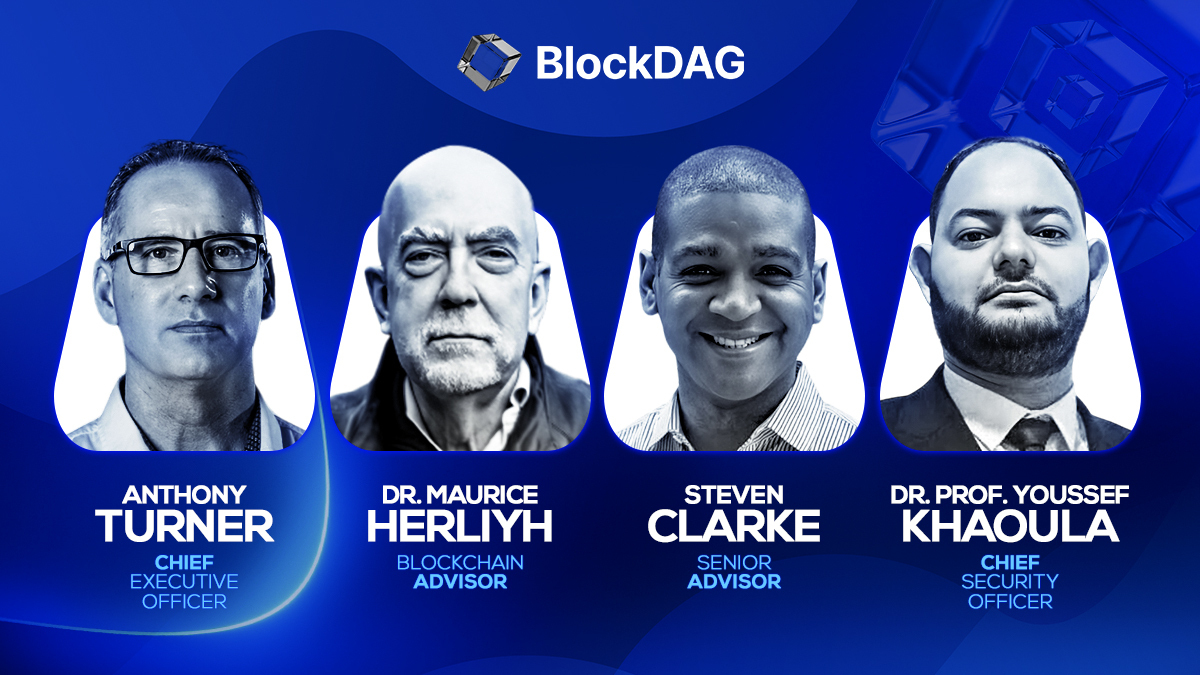
BlockDAG Network’s history is one of innovation, perseverance, and a vision to push the boundaries of blockchain technology. With Harvard alumni, tech moguls, and best-selling authors at the helm, BlockDAG is rewriting the rules of the cryptocurrency game.
CEO Antony Turner, inspired by the successes and shortcomings of Bitcoin and Ethereum, says, “BlockDAG leverages existing technology to push the boundaries of speed, security, and decentralization.” This powerhouse team has led a staggering 1,600% price increase in 20 pre-sale rounds, raising over $63.9 million. The secret? Unparalleled expertise and a bold vision for the future of blockchain.
Let’s dive into BlockDAG’s success story and find out what the future holds for this cryptocurrency.
The Origin: Why BlockDAG Was Created
In a recent interview, BlockDAG CEO Antony Turner perfectly summed up why the market needs BlockDAG’s ongoing revolution. He said:
“The creation of BlockDAG was inspired by Bitcoin and Ethereum, their successes and their shortcomings.
If you look at almost any new technology, it is very rare that the first movers remain at the forefront forever. Later incumbents have a huge advantage in entering a market where the need has been established and the technology is no longer cutting edge.
BlockDAG has done just that: our innovation is incorporating existing technology to provide a better solution, allowing us to push the boundaries of speed, security, and decentralization.”
The Present: How Far Has BlockDAG Come?
BlockDAG’s presale is setting new benchmarks in the cryptocurrency investment landscape. With a stunning 1600% price increase over 20 presale lots, it has already raised over $63.9 million in capital, having sold over 12.43 billion BDAG coins.
This impressive performance underscores the overwhelming confidence of investors in BlockDAG’s vision and leadership. The presale attracted over 20,000 individual investors, with the BlockDAG community growing exponentially by the hour.
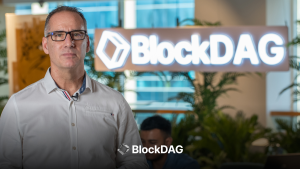
These monumental milestones have been achieved thanks to the unparalleled skills, experience and expertise of BlockDAG’s management team:
Antony Turner – Chief Executive Officer
Antony Turner, CEO of BlockDAG, has over 20 years of experience in the Fintech, EdTech, Travel and Crypto industries. He has held senior roles at SPIRIT Blockchain Capital and co-founded Axona-Analytics and SwissOne. Antony excels in financial modeling, business management and scaling growth companies, with expertise in trading, software, IoT, blockchain and cryptocurrency.
Director of Communications
Youssef Khaoulaj, CSO of BlockDAG, is a Smart Contract Auditor, Metaverse Expert, and Red Team Hacker. He ensures system security and disaster preparedness, and advises senior management on security issues.
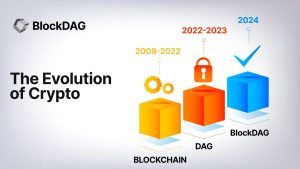
advisory Committee
Steven Clarke-Martin, a technologist and consultant, excels in enterprise technology, startups, and blockchain, with a focus on DAOs and smart contracts. Maurice Herlihy, a Harvard and MIT graduate, is an award-winning computer scientist at Brown University, with experience in distributed computing and consulting roles, most notably at Algorand.
The Future: Becoming the Cryptocurrency with the Highest Market Cap in the World
Given its impressive track record and a team of geniuses working tirelessly behind the scenes, BlockDAG is quickly approaching the $600 million pre-sale milestone. This crypto powerhouse will soon enter the top 30 cryptocurrencies by market cap.
Currently trading at $0.017 per coin, BlockDAG is expected to hit $1 million in the coming months, with the potential to hit $30 per coin by 2030. Early investors have already enjoyed a 1600% ROI by batch 21, fueling a huge amount of excitement around BlockDAG’s presale. The platform is seeing significant whale buying, and demand is so high that batch 21 is almost sold out. The upcoming batch is expected to drive prices even higher.

Invest in BlockDAG Pre-Sale Now:
Pre-sale: https://purchase.blockdag.network
Website: https://blockdag.network
Telegram: https://t.me/blockDAGnetwork
Discord: Italian: https://discord.gg/Q7BxghMVyu
No spam, no lies, just insights. You can unsubscribe at any time.
Tech
How Karak’s Latest Tech Integration Could Make Data Breaches Obsolete

- Space and Time uses zero-knowledge proofs to ensure secure and tamper-proof data processing for smart contracts and enterprises.
- The integration facilitates faster development and deployment of Distributed Secure Services (DSS) on the Karak platform.
Karak, a platform known for its strong security capabilities, is enhancing its Distributed Secure Services (DSS) by integrating Space and Time as a zero-knowledge (ZK) coprocessor. This move is intended to strengthen trustless operations across its network, especially in slashing and rewards mechanisms.
Space and Time is a verifiable processing layer that uses zero-knowledge proofs to ensure that computations on decentralized data warehouses are secure and untampered with. This system enables smart contracts, large language models (LLMs), and enterprises to process data without integrity concerns.
The integration with Karak will enable the platform to use Proof of SQL, a new ZK-proof approach developed by Space and Time, to confirm that SQL query results are accurate and have not been tampered with.
One of the key features of this integration is the enhancement of DSS on Karak. DSS are decentralized services that use re-staked assets to secure the various operations they provide, from simple utilities to complex marketplaces. The addition of Space and Time technology enables faster development and deployment of these services, especially by simplifying slashing logic, which is critical to maintaining security and trust in decentralized networks.
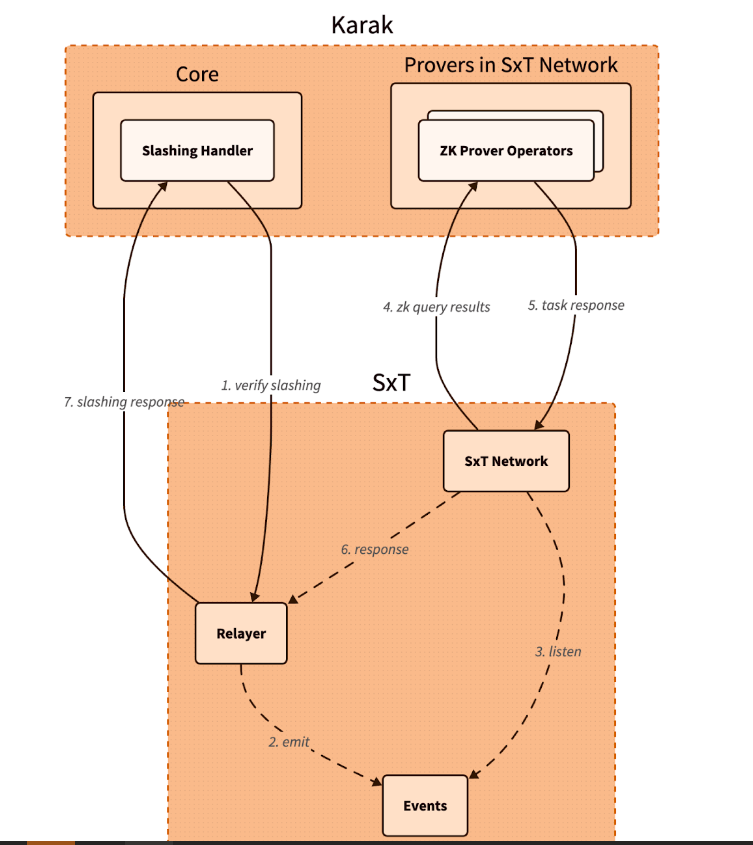
Additionally, Space and Time is developing its own DSS for blockchain data indexing. This service will allow community members to easily participate in the network by running indexing nodes. This is especially beneficial for applications that require high security and decentralization, such as decentralized data indexing.
The integration architecture follows a detailed and secure flow. When a Karak slashing contract needs to verify a SQL query, it calls the Space and Time relayer contract with the required SQL statement. This contract then emits an event with the query details, which is detected by operators in the Space and Time network.
These operators, responsible for indexing and monitoring DSS activities, validate the event and route the work to a verification operator who runs the query and generates the necessary ZK proof.
The result, along with a cryptographic commitment on the queried data, is sent to the relayer contract, which verifies and returns the data to the Karak cutter contract. This end-to-end process ensures that the data used in decision-making, such as determining penalties within the DSS, is accurate and reliable.
Karak’s mission is to provide universal security, but it also extends the capabilities of Space and Time to support multiple DSSs with their data indexing needs. As these technologies evolve, they are set to redefine the secure, decentralized computing landscape, making it more accessible and efficient for developers and enterprises alike. This integration represents a significant step towards a more secure and verifiable digital infrastructure in the blockchain space.
Website | X (Twitter) | Discord | Telegram
No spam, no lies, just insights. You can unsubscribe at any time.
Tech
Cryptocurrency Payments: Should CFOs Consider This Ferrari-Approved Trend?

Iconic Italian luxury carmaker Ferrari has announced the expansion of its cryptocurrency payment system to its European dealer network.
The move, which follows a successful launch in North America less than a year ago, raises a crucial question for CFOs across industries: Is it time to consider accepting cryptocurrency as a form of payment for your business?
Ferrari’s move isn’t an isolated one. It’s part of a broader trend of companies embracing digital assets. As of 2024, we’re seeing a growing number of companies, from tech giants to traditional retailers, accepting cryptocurrencies.
This change is determined by several factors:
- Growing mainstream adoption of cryptocurrencies
- Growing demand from tech-savvy and affluent consumers
- Potential for faster and cheaper international transactions
- Desire to project an innovative brand image
Ferrari’s approach is particularly noteworthy. They have partnered with BitPay, a leading cryptocurrency payment processor, to allow customers to purchase vehicles using Bitcoin, Ethereum, and USDC. This satisfies their tech-savvy and affluent customer base, many of whom have large digital asset holdings.
Navigating Opportunities and Challenges
Ferrari’s adoption of cryptocurrency payments illustrates several key opportunities for companies considering this move. First, it opens the door to new customer segments. By accepting cryptocurrency, Ferrari is targeting a younger, tech-savvy demographic—people who have embraced digital assets and see them as a legitimate form of value exchange. This strategy allows the company to connect with a new generation of affluent customers who may prefer to conduct high-value transactions in cryptocurrency.
Second, cryptocurrency adoption increases global reach. International payments, which can be complex and time-consuming with traditional methods, become significantly easier with cryptocurrency transactions. This can be especially beneficial for businesses that operate in multiple countries or deal with international customers, as it potentially reduces friction in cross-border transactions.
Third, accepting cryptocurrency positions a company as innovative and forward-thinking. In today’s fast-paced business environment, being seen as an early adopter of emerging technologies can significantly boost a brand’s image. Ferrari’s move sends a clear message that they are at the forefront of financial innovation, which can appeal to customers who value cutting-edge approaches.
Finally, there is the potential for cost savings. Traditional payment methods, especially for international transactions, often incur substantial fees. Cryptocurrency transactions, on the other hand, can offer lower transaction costs. For high-value purchases, such as luxury cars, these savings could be significant for both the business and the customer.
While the opportunities are enticing, accepting cryptocurrency payments also presents significant challenges that businesses must address. The most notable of these is volatility. Cryptocurrency values can fluctuate dramatically, sometimes within hours, posing potential risk to businesses that accept them as payment. Ferrari addressed this challenge by implementing a system that instantly converts cryptocurrency received into traditional fiat currencies, effectively mitigating the risk of value fluctuations.
Regulatory uncertainty is another major concern. The legal landscape surrounding cryptocurrencies is still evolving in many jurisdictions around the world. This lack of clear and consistent regulations can create compliance challenges for companies, especially those operating internationally. Companies must remain vigilant and adaptable as new laws and regulations emerge, which can be a resource-intensive process.
Implementation costs are also a significant obstacle. Integrating cryptocurrency payment systems often requires substantial investment in new technology infrastructure and extensive staff training. This can be especially challenging for small businesses or those with limited IT resources. The costs are not just financial; a significant investment of time is also required to ensure smooth implementation and operation.
Finally, security concerns loom large in the world of cryptocurrency transactions. While blockchain technology offers some security benefits, cryptocurrency transactions still require robust cybersecurity measures to protect against fraud, hacks, and other malicious activity. Businesses must invest in robust security protocols and stay up-to-date on the latest threats and protections, adding another layer of complexity and potential costs to accepting cryptocurrency payments.
Strategic Considerations for CFOs
If you’re thinking of following in Ferrari’s footsteps, here are the key factors to consider:
- Risk Assessment: Carefully evaluate potential risks to your business, including financial, regulatory, and reputational risks.
- Market Analysis: Evaluate whether your customer base is significantly interested in using cryptocurrencies for payments.
- Technology Infrastructure: Determine the costs and complexities of implementing a cryptographic payment system that integrates with existing financial processes.
- Regulatory Compliance: Ensure that cryptocurrency acceptance is in line with local regulations in all markets you operate in. Ferrari’s gradual rollout demonstrates the importance of this consideration.
- Financial Impact: Analyze how accepting cryptocurrency could impact your cash flow, accounting practices, and financial reporting.
- Partnership Evaluation: Consider partnering with established crypto payment processors to reduce risk and simplify implementation.
- Employee Training: Plan comprehensive training to ensure your team is equipped to handle cryptocurrency transactions and answer customer questions.
While Ferrari’s adoption of cryptocurrency payments is exciting, it’s important to consider this trend carefully.
A CFO’s decision to adopt cryptocurrency as a means of payment should be based on a thorough analysis of your company’s specific needs, risk tolerance, and strategic goals. Cryptocurrency payments may not be right for every business, but for some, they could provide a competitive advantage in an increasingly digital marketplace.
Remember that the landscape is rapidly evolving. Stay informed about regulatory changes, technological advancements, and changing consumer preferences. Whether you decide to accelerate your crypto engines now or wait in the pit, keeping this payment option on your radar is critical to navigating the future of business transactions.
Was this article helpful?
Yes No
Sign up to receive your daily business insights
Tech
Bitcoin Tumbles as Crypto Market Selloff Mirrors Tech Stocks’ Plunge
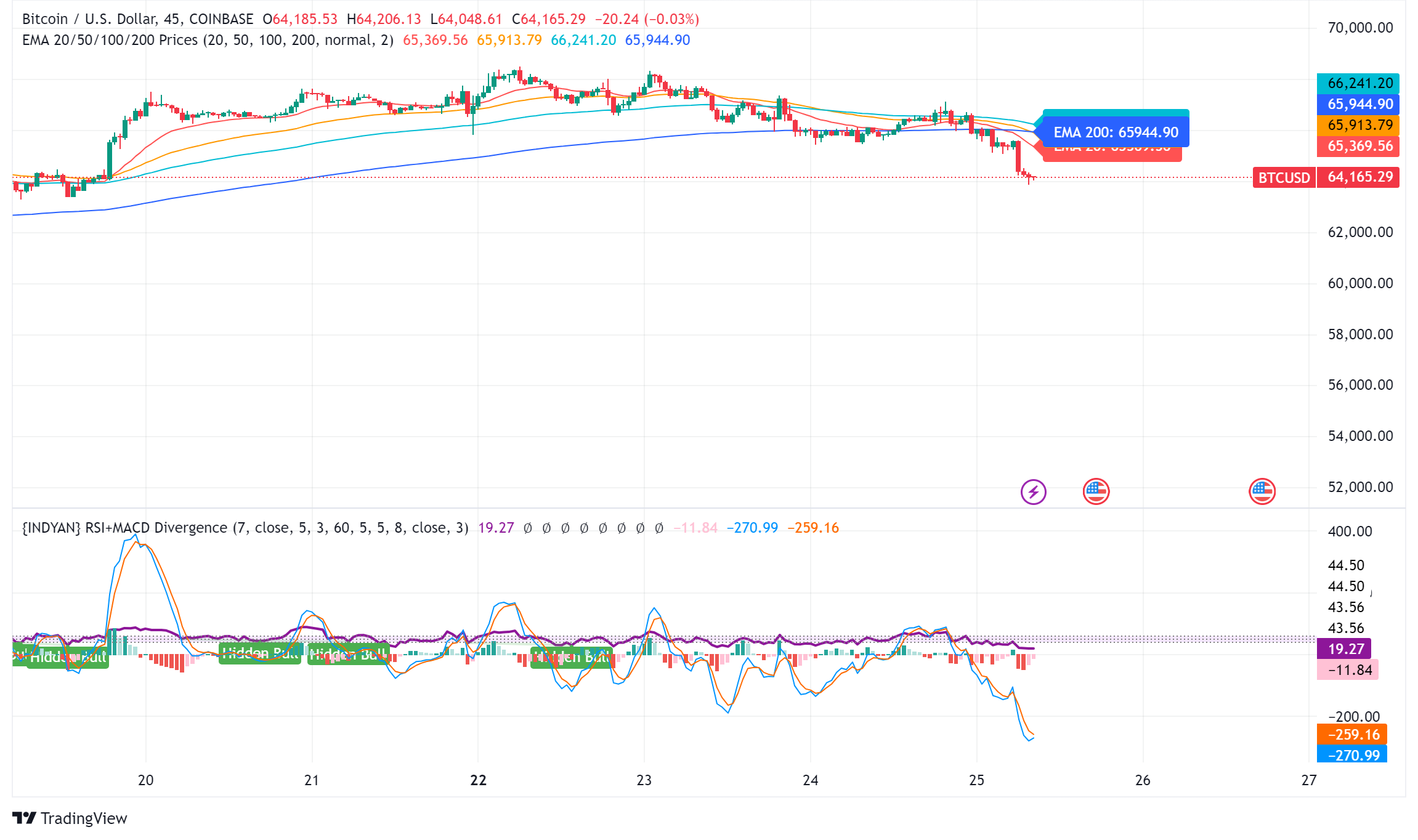
The world’s largest cryptocurrency, Bitcoin (BTC), suffered a significant price decline on Wednesday, falling below $65,000. The decline coincides with a broader market sell-off that has hit technology stocks hard.
Cryptocurrency Liquidations Hit Hard
CoinGlass data reveals a surge in long liquidations in the cryptocurrency market over the past 24 hours. These liquidations, totaling $220.7 million, represent forced selling of positions that had bet on price increases. Bitcoin itself accounted for $14.8 million in long liquidations.
Ethereum leads the decline
Ethereal (ETH), the second-largest cryptocurrency, has seen a steeper decline than Bitcoin, falling nearly 8% to trade around $3,177. This decline mirrors Bitcoin’s price action, suggesting a broader market correction.
Cryptocurrency market crash mirrors tech sector crash
The cryptocurrency market decline appears to be linked to the significant losses seen in the U.S. stock market on Wednesday. Stock market listing The index, heavily weighted toward technology stocks, posted its sharpest decline since October 2022, falling 3.65%.
Analysts cite multiple factors
Several factors may have contributed to the cryptocurrency market crash:
- Tech earnings are underwhelming: Earnings reports from tech giants like Alphabet are disappointing (Google(the parent company of), on Tuesday, triggered a sell-off in technology stocks with higher-than-expected capital expenditures that could have repercussions on the cryptocurrency market.
- Changing Political Landscape: The potential impact of the upcoming US elections and changes in Washington’s policy stance towards cryptocurrencies could influence investor sentiment.
- Ethereal ETF Hopes on the line: While bullish sentiment around a potential U.S. Ethereum ETF initially boosted the market, delays or rejections could dampen enthusiasm.
Analysts’ opinions differ
Despite the short-term losses, some analysts remain optimistic about Bitcoin’s long-term prospects. Singapore-based cryptocurrency trading firm QCP Capital believes Bitcoin could follow a similar trajectory to its post-ETF launch all-time high, with Ethereum potentially converging with its previous highs on sustained institutional interest.
Rich Dad Poor Dad Author’s Prediction
Robert Kiyosaki, author of the best-selling Rich Dad Poor Dad, predicts a potential surge in the price of Bitcoin if Donald Trump is re-elected as US president. He predicts a surge to $105,000 per coin by August 2025, fueled by a weaker dollar that is set to boost US exports.
BTC/USD Technical Outlook
Bitcoin price is currently trading below key support levels, including the $65,500 level and the 100 hourly moving average. A break below the $64,000 level could lead to further declines towards the $63,200 support zone. However, a recovery above the $65,500 level could trigger another increase in the coming sessions.
-

 Videos4 weeks ago
Videos4 weeks agoAbsolutely massive: the next higher Bitcoin leg will shatter all expectations – Tom Lee
-

 News12 months ago
News12 months agoVolta Finance Limited – Director/PDMR Shareholding
-

 News12 months ago
News12 months agoModiv Industrial to release Q2 2024 financial results on August 6
-

 News12 months ago
News12 months agoApple to report third-quarter earnings as Wall Street eyes China sales
-

 News12 months ago
News12 months agoNumber of Americans filing for unemployment benefits hits highest level in a year
-

 News1 year ago
News1 year agoInventiva reports 2024 First Quarter Financial Information¹ and provides a corporate update
-

 News1 year ago
News1 year agoLeeds hospitals trust says finances are “critical” amid £110m deficit
-

 Markets1 year ago
Markets1 year agoWhale Investments in Bitcoin Hit $100 Billion in 2024, Fueling Insane Investor Optimism ⋆ ZyCrypto
-

 DeFi1 year ago
DeFi1 year ago🏴☠️ Pump.Fun operated by Insider Exploit
-

 Videos1 year ago
Videos1 year ago$1,000,000 worth of BTC in 2025! Get ready for an UNPRECEDENTED PRICE EXPLOSION – Jack Mallers
-

 Videos1 year ago
Videos1 year agoABSOLUTELY HUGE: Bitcoin is poised for unabated exponential growth – Mark Yusko and Willy Woo
-

 Tech1 year ago
Tech1 year agoBlockDAG ⭐⭐⭐⭐⭐ Review: Is It the Next Big Thing in Cryptocurrency? 5 questions answered





